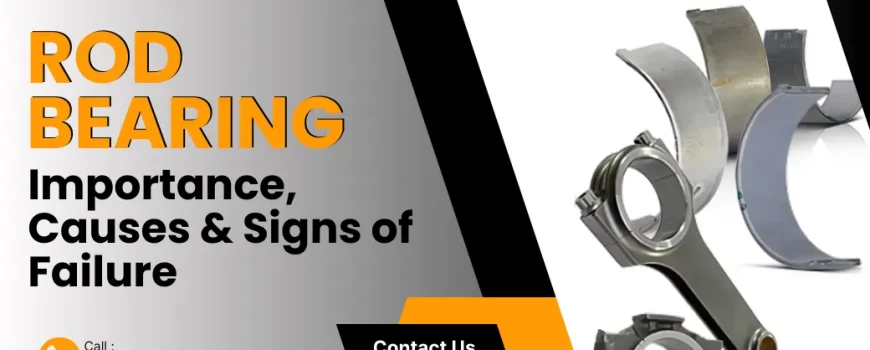Your vehicle comprises many small or big parts that you might have never heard of. Everyone is aware of the engine, steering, brakes, and suspension. But I think there will be only a few who have heard about rod bearing. It is responsible for the smooth and flawless working of the engine. Want to know more about rod bearing and its functions? Do you know what can happen if they fail or what are its signs of failure? Let’s delve deeper into the concept of rod-bearing-
What is a rod bearing?
Rod bearing or connecting rod bearing is one of the important parts of an internal combustion engine. It is located between the piston and the crankshaft. The primary role of rod bearing is to let the crankshaft rotate freely in the engaged whole reducing friction. They connect, guide, and support the connecting rods with the crankshaft. these connecting rods move against each other in constant motion. This transforms the piston’s stroke movement to the circular rotary movement of the crankshaft for rotation. Also, they bear the load during engine operation and absorb and distribute the forces produced evenly.
There are several types of rod bearings-
- Plain bearings
- Ball bearing
- Rolling bearings
Rod bearings are different from each other based on material, size, rod type, and bearing seal. These are made of durable metals that can withstand high pressure and heat like steel or copper. Also, they are efficient in carrying different loading weights. For example, ball bearings are efficient in handling smaller weight loads, whereas rolling bearings are capable of handling heavier loads.
Importance of rod bearing
A rod bearing is more than just a connector between the piston and the crankshaft. It plays an important role in the performance and longevity of the internal combustion engine. The main function of a rod bearing is to reduce the friction between the moving parts. Also, to ensure the smooth rotational functioning of the crankshaft.
Support the crankshaft
Rod bearings allow the connecting rods to move smoothly in the crankshaft journal, further supporting the crankshaft. They are lubricated with oil to create a hydrodynamic lubrication layer. This further prevents direct contact between the connection rod and the crankshaft. The support by rod bearings allows the crankshaft to rotate at high speed to transmit power. This is important for the smooth working of the engine to drive the vehicle.
Motion Conversion
Rod bearings have an important role in the operations of internal combustion engines. It covers the linear motion into rotational motion which is crucial for moving or running the vehicle. When pistons move up and down, the motion is transferred to the crankshaft through the connecting rod bearings. It ensures smooth transfer and conversion of motion from the piston to the crankshaft for the combustion process to power up the vehicle.
Reduced friction
The rod bearings are lubricated with oil, which creates a thin layer between the bearing surface and the crankshaft. This minimizes metal-to-metal contact or friction between the crankshaft and the connecting rod during the engine operation. This further reduces overheating and wear and tear of the engine parts. Also, it leads to better fuel economy and smooth working of the engine.
Load distribution
It also has an important role to play in the distribution of loads while the engine is in operation. During the combustion process, a huge amount of pressure is generated and exerted on the piston. The rod bearings transfer this pressure evenly to ensure that the connecting rod and crankshaft do not experience stress at a single point. This reduces the wear and tear of the components and the risk of crankshaft failure.
Overheat prevention
When metals come in direct contact, excessive heat is produced. As a result of this, significant damage can be caused to bearings. This further increases the risk of engine failure. To prevent overheating, the rod bearings reduce friction between the moving parts during the engine operation. A thin layer of oil acts as a cooling agent to prevent engine overheating.
By protecting the rod bearings from wear and tear, you can ensure optimal performance of the engine.
Causes of rod bearing failure
Rod bearing failure is one of the key issues that can cause huge damage to other engine components. This can increase downtime, and damage the engine and crankshaft, thus leading to high repair costs. There can be several causes of rod-bearing failure-
Improper Lubrication
To function properly, the rod bear requires lubrication. The thin layer created by oil reduces friction and prevents overheating. Improper lubrication can cause dry friction, further increasing the wear of connecting rod bearings. This eventually leads to failure.
Bearing material fatigue
The excessive pressure and overload on connecting rod bearings can result in overlay or bearing material fatigue. This means that fine cracks, scratches, and imperfections formed on the connecting rod bearings. As a result of this, the micro-cracks can be formed eventually leading to fracture.
Misalignment of parts
Misalignment of components can cause severe damage to the bearings further leading to failure. Improper shim installation, misaligned shafts, and belts are the primary causes of rotating component breakdown and bearing fatigue.
Mixed lubrication
Due to dirt, debris, and dust in the lubricating oil, the likelihood of metal-to-metal contact between the bearing and crankshaft increases. Dirt build-up in oil increases friction, as well as wear on the bearing surface. Furthermore, it can also lead to overheating affecting engine performance.
These factors can damage the rod bearings, further leading to serious damage to the engine and its components.
Signs of rod bearing failure
To prevent rod bearing failure, you can keep check on a few signs-
- Excessive knocking and rattling sounds from the engine.
- Illuminated oil pressure light
- Presence of tiny metal particles in the engine oil during the oil change.
- Engine overheating under heavy loads.
- Unusual vibration due to misalignment
If you notice any of these signs, it is important to take immediate action to prevent further damage to the rod bearings and engine.
How to prevent rod bearing failure?
You can adopt several ways to ensure the health of connecting rod bearings and prevent failure-
- Select bearings of the right size with a suitable load capacity for your vehicle.
- Ensure proper installment of connecting rod bearings.
- Regularly change the oil to ensure the bearings are lubricated.
- Use high-quality oil to prevent dirt build-up and contamination.
- Keep a regular check on an oil pressure gauge.
- Clean bearings and apply anti-corrosion from time to time.
By following these steps, you can protect connecting rod bearings, engine, and other parts, as well as your money.
Looking for a connecting rod bearing replacement
Are you looking for a connecting rod bearing replacement, look no further. Here at JCBL India, we manufacture and supply high-quality connecting rod bearings, engine parts, and other automotive afterparts. As rod bearings are important for the smooth working and safety of vehicles, it is important to use high-quality connecting rod bearings to optimize engine performance. Our products are designed to meet the quality standards of the international market. Visit our website to check our products.
Conclusion
In conclusion, the rod bearings might seem like a small part of your engine. But it plays a big part in ensuring that everything runs smoothly. The efficiency and longevity of your rod bearings are in your own hands. Through regular inspection and maintenance, you can prevent rod bearing failure. Remember that your little carelessness can cause severe damage to your engine, as well as to your pocket.
FAQ’s
What happens when a rod bearing fails?
Rod bearing failure has a snowball effect. with its failure, all other parts of the engine including the crankshaft and bearings start to fail, leading to engine failure.
What happens if you drive with a bad rod bearing?
Driving with bad rod bearings can further damage the engine and its components. The overall performance and longevity are affected. Thus, it is important to address the issue of bad rod bearing as soon as possible.

